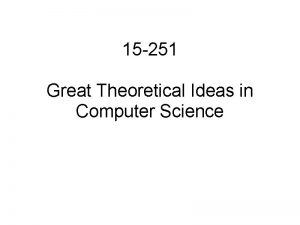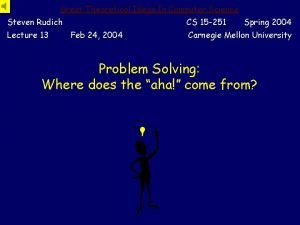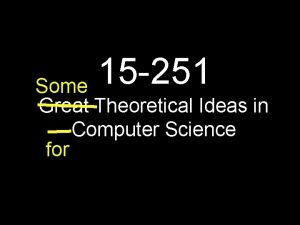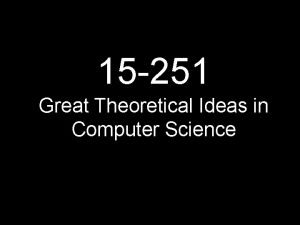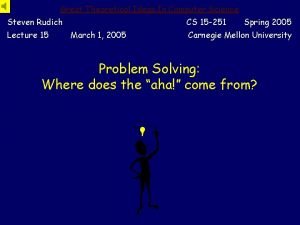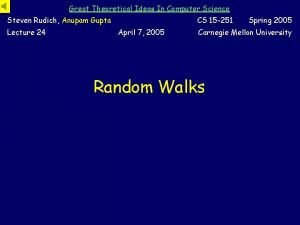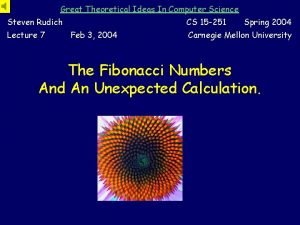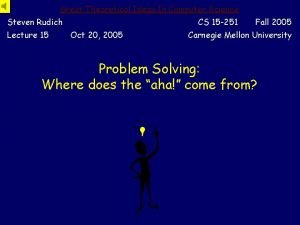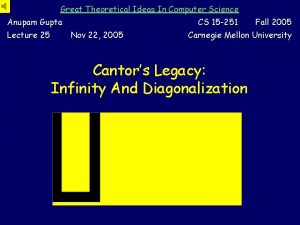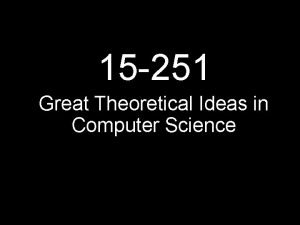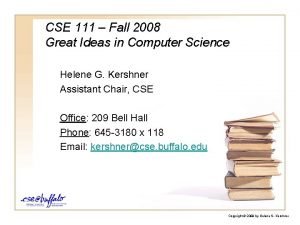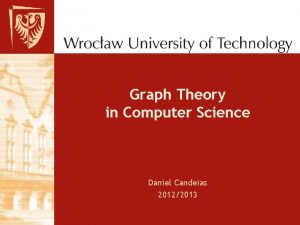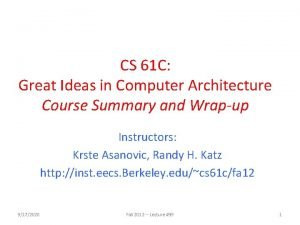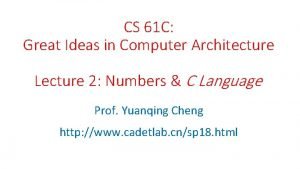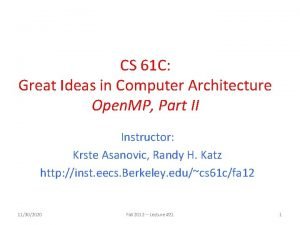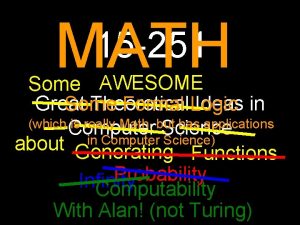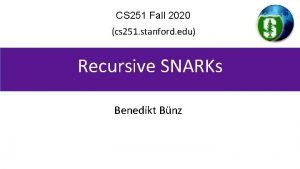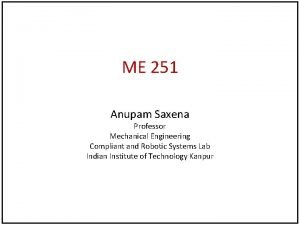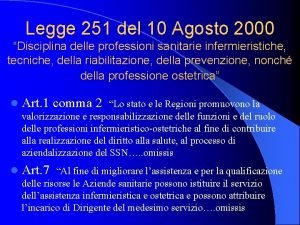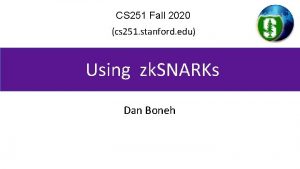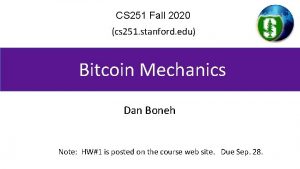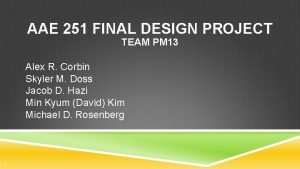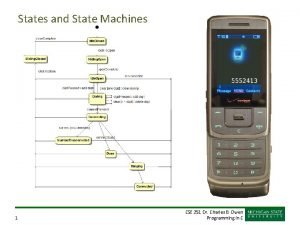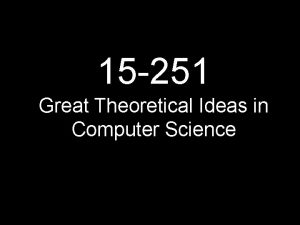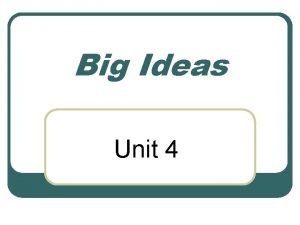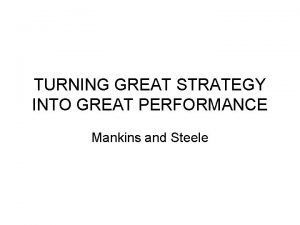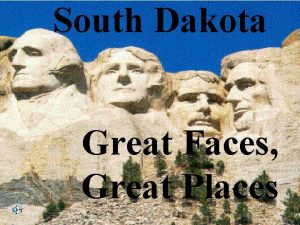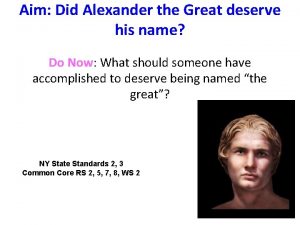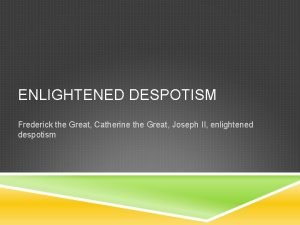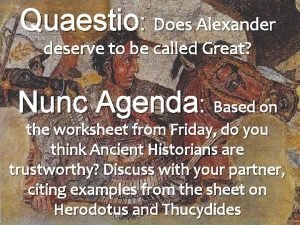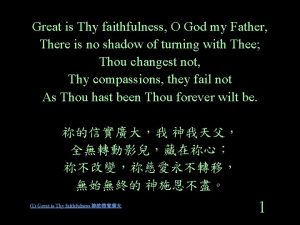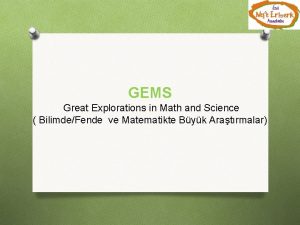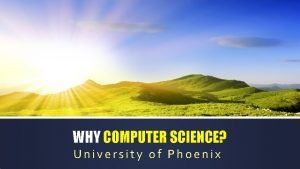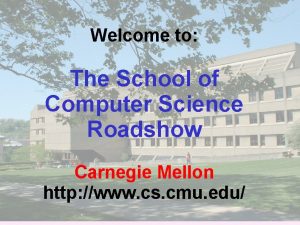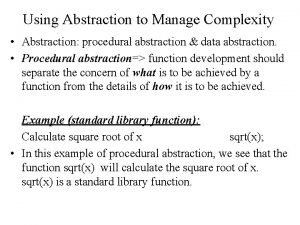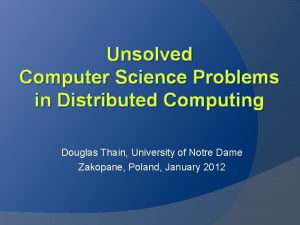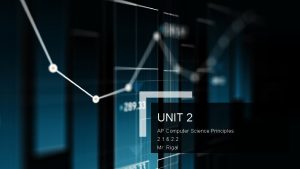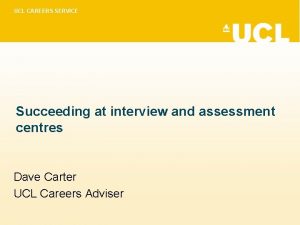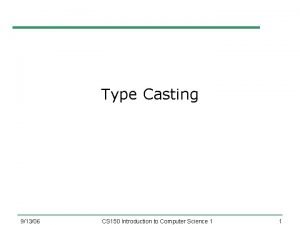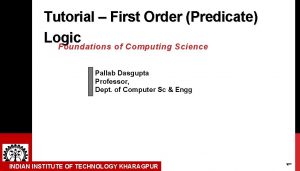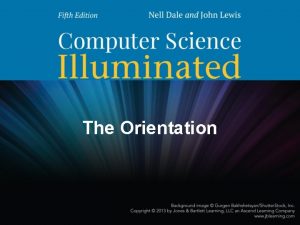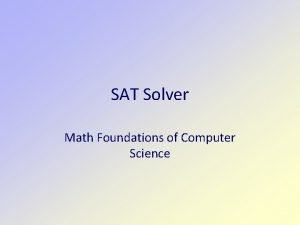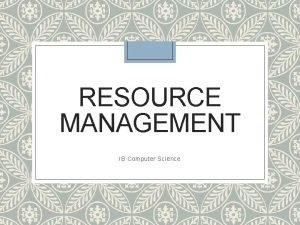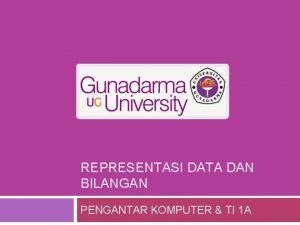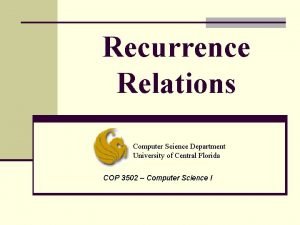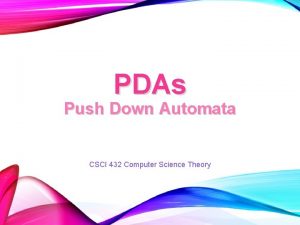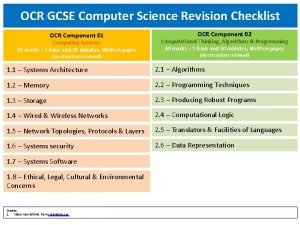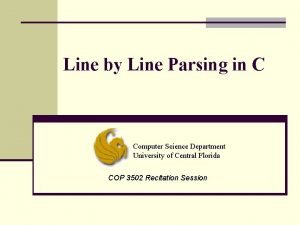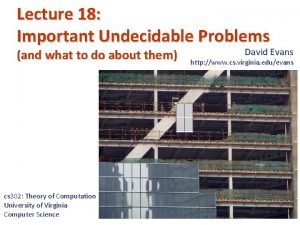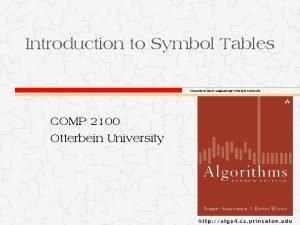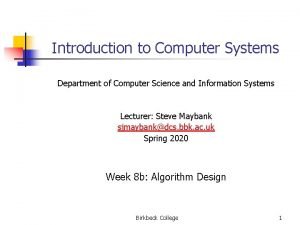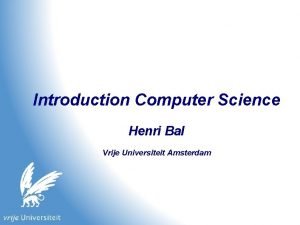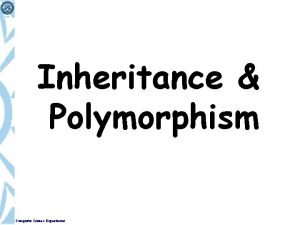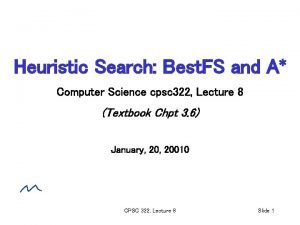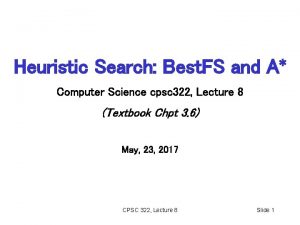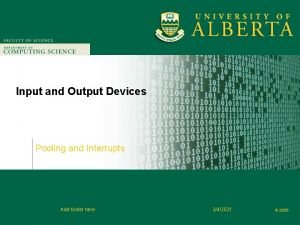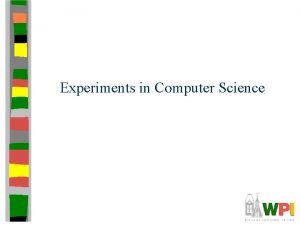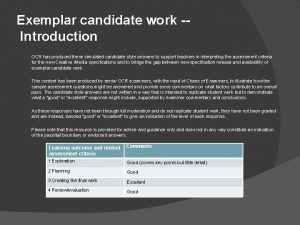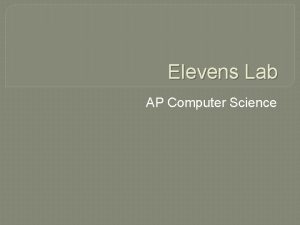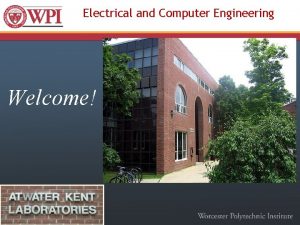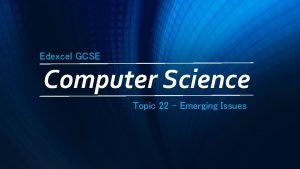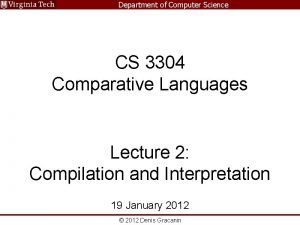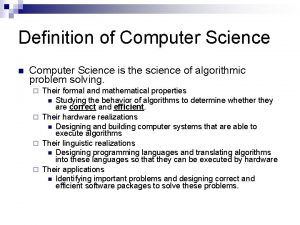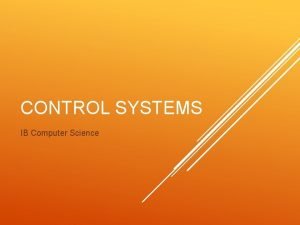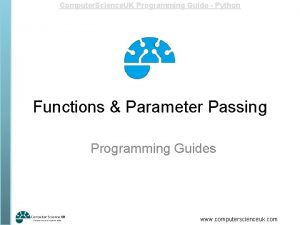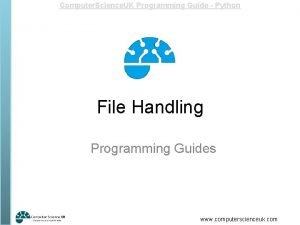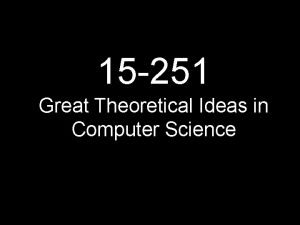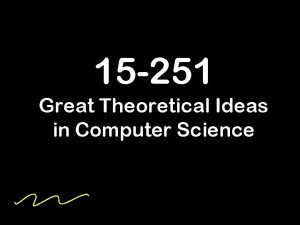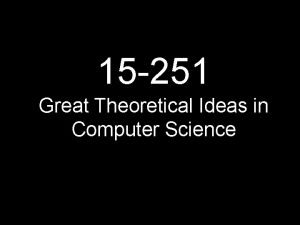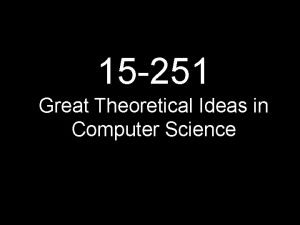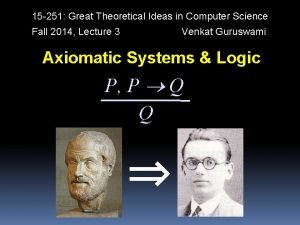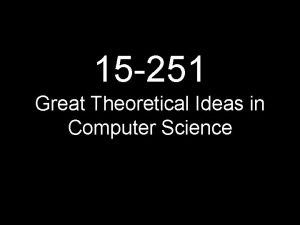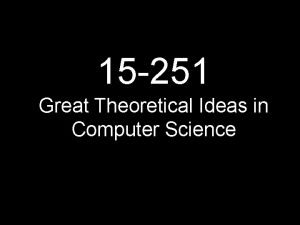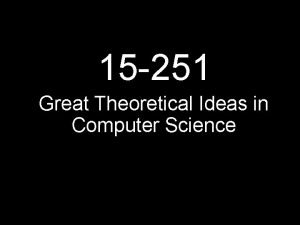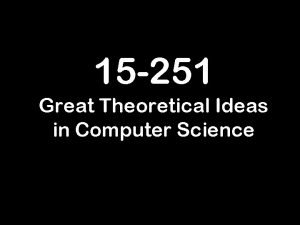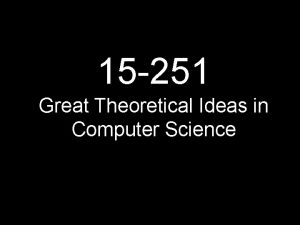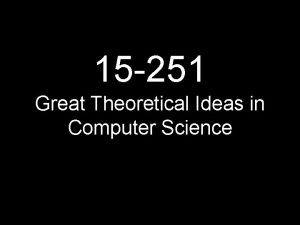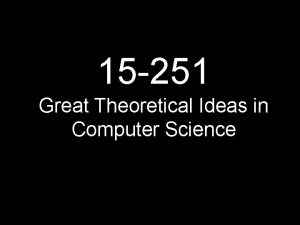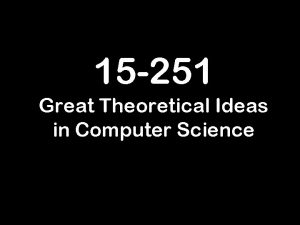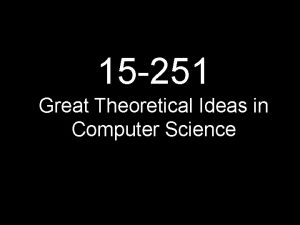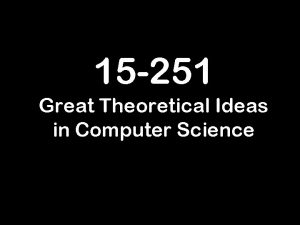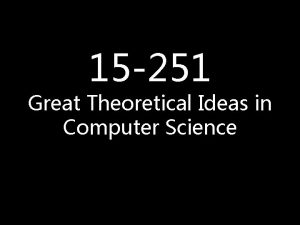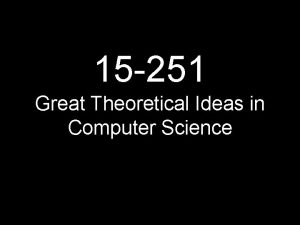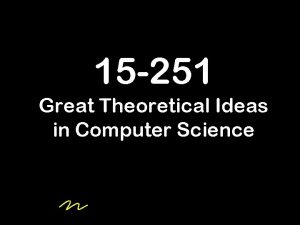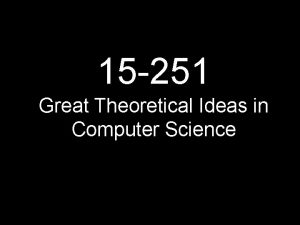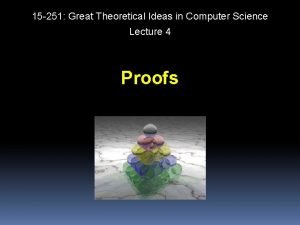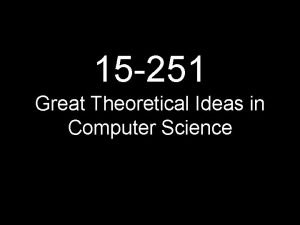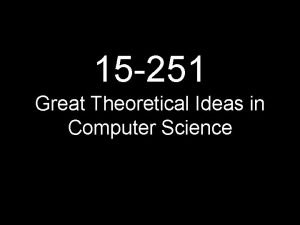15 251 Great Theoretical Ideas in Computer Science



































































































- Slides: 99

15 -251 Great Theoretical Ideas in Computer Science

Lecture 21 - Dan Kilgallin Turing Machines

Goals a. Describe the nature of computation b. Mathematically formalize the behavior of a program running on a computer system c. Compare the capabilities of different programming languages

Turing Machines a. What can we do to make a DFA better? b. Idea: Give it some memory! c. How much memory? d. Infinite! e. What kind of memory? Sequential access (e. g. CD, hard drive) or RAM? f. An infinite amount of RAM requires remembering really big numbers and needlessly complicates proofs

Turing Machines: Definition a. A Turing Machine consists of a. A DFA to store the machine state, called the controller b. An array that is infinitely long in both directions, called the tape c. A pointer to some particular cell in the array, called the head

Operation � a. � The head begins at cell 0 on the tape b. The DFA begins in some initial state c. Symbols from some alphabet are written on a finite portion of the tape, beginning at cell 1

Operation � a. At each step, the machine uses as input: a. The state of the controller b. The symbol written on the cell which the head is at b. Using this, the machine will: a. Transition to some state in the DFA (possibly the same state) b. Write some symbol (possibly the same symbol) on the tape c. Move the head left or right one cell

Two Flavors! a. The machine will stop computation if the DFA enters one of a pre-defined set of "halting" states b. � A "decision" machine will, if it reaches a halting state, output either "Yes" or "No" (i. e. there are "accepting" and "rejecting" halt states) c. A "function" machine will, if it reaches a halting state, have some string of symbols written on the tape. This string of symbols is the output of the function

Example: Doubling a Number 0 1 2 3 4 5 Notation: (old symbol, new symbol, direction to move) "epsilon" denotes empty cell, "H" denotes halting state(s)

Example: Doubling a Number 0 1 2 3 4 5

Example: Doubling a Number 0 1 2 3 4 5

Example: Doubling a Number 0 1 2 3 4 5

Example: Doubling a Number 0 1 2 3 4 5

Example: Doubling a Number 0 1 2 3 4 5

Example: Doubling a Number 0 1 2 3 4 5

Example: Doubling a Number 0 1 2 3 4 5

Example: Doubling a Number 0 1 2 3 4 5

Example: Doubling a Number 0 1 2 3 4 5

Example: Doubling a Number 0 1 2 3 4 5

Example: Doubling a Number 0 1 2 3 4 5

Example: Doubling a Number 0 1 2 3 4 5

Example: Doubling a Number 0 1 2 3 4 5

Example: Doubling a Number 0 1 2 3 4 5

Example: Doubling a Number 0 1 2 3 4 5

Example: Doubling a Number 0 1 2 3 4 5

Example: Doubling a Number 0 1 2 3 4 5

TM vs DFA a. Is a decision machine more powerful than a DFA? b. Yes! c. Claim: A decision machine can recognize the set {anbn | n >= 0}

Example: anbn

Example: anbn 0 1 2 3 4 5

Example: anbn 0 1 2 3 4 5

Example: anbn 0 1 2 3 4 5

Example: anbn 0 1 2 3 4 5

Example: anbn 0 1 2 3 4 5

Example: anbn 0 1 2 3 4 5

Example: anbn 0 1 2 3 4 5

Example: anbn 0 1 2 3 4 5

Example: anbn 0 1 2 3 4 5

Example: anbn 0 1 2 3 4 5

Example: anbn 0 1 2 3 4 5

Example: anbn 0 1 2 3 4 5

Example: anbn 0 1 2 3 4 5

Example: anbn 0 1 2 3 4 5

Example: anbn 0 1 2 3 4 5

Example: anbn 0 1 2 3 4 5

Correctness a. Every time we reach the bottom-right state, the number of "b"s deleted equals the number of "a"s

Correctness 0 1 2 3 4 5

Correctness a. Every time we reach the bottom-right state, the number of "b"s deleted equals the number of "a"s b. If there are more "a"s, it crashes right after deleting the last "b"

Correctness 0 1 2 3 4 5 No "a" transition!

Correctness a. Every time we reach the bottom-right state, the number of "b"s deleted equals the number of "a"s b. If there are more "a"s, it crashes right after deleting the last "b" c. If there are more "b"s, it crashes in the bottom-right state after scanning to the left of the "b"s

Correctness 0 1 2 3 4 5 No epsilon transition!

Correctness a. Every time we reach the bottom-right state, the number of "b"s deleted equals the number of "a"s b. If there are more "a"s, it crashes right after deleting the last "b" c. If there are more "b"s, it crashes in the bottom-right state after scanning to the left of the "b"s d. If NO "a"s, crashes immediately

Correctness 0 1 2 3 4 5 No "b" transition!

Correctness a. Every time we reach the bottom-right state, the number of "b"s deleted equals the number of "a"s b. If there are more "a"s, it crashes right after deleting the last "b" c. If there are more "b"s, it crashes in the bottom-right state after scanning to the left of the "b"s d. If NO "a"s, crashes immediately e. If no "b"s, crashes after reading the "a"s

Correctness 0 1 2 3 4 5 No epsilon transition!

Definitions a. � A set is recursively enumerable if there is a decision machine which answers "yes" if and only if the input belongs to the set b. A function f is computable or recursive if there is a function machine that, when given input x, produces output f(x)

Interlude: What is an "algorithm"? a. "A precise step-by-step plan for a computational procedure that begins with an input value and yields an output value in a finite number of steps. " -Corbin, Leiserson, Rivest. "Introduction to Algorithms" • Turing machines can capture this notion precisely!

Algorithms on a TM a. Given a human-comprehensible goal, encode the input into some alphabet b. Define the steps of the algorithm as a DFA c. Put the input on a tape d. Let the Turing Machine run e. Translate the output

Objection a. Why not just use a programming language, such as C? b. As it turns out, writing a C program is just using a computer to build a Turing Machine for you

Algorithms on a TM a. Given a human-comprehensible goal, encode the input into some alphabet b. Define the steps of the algorithm as a DFA c. Put the input on a tape d. Let the Turing Machine run e. Translate the output

Algorithms in C a. Given a human-comprehensible goal, encode the input into some alphabet b. Define the steps of the algorithm as a DFA c. Put the input on a tape d. Let the Turing Machine run e. Translate the output

Algorithms in C a. Given a human-comprehensible goal, encode the input into binary b. Define the steps of the algorithm as a DFA c. Put the input on a tape d. Let the Turing Machine run e. Translate the output

Algorithms in C a. Given a human-comprehensible goal, encode the input into binary b. Define the steps of the algorithm as a sequence of processor instructions c. Put the input on a tape d. Let the Turing Machine run e. Translate the output

Algorithms in C a. Given a human-comprehensible goal, encode the input into binary b. Define the steps of the algorithm as a sequence of processor instructions c. Put the input in computer memory d. Let the Turing Machine run e. Translate the output

Algorithms in C a. Given a human-comprehensible goal, encode the input into binary b. Define the steps of the algorithm as a sequence of processor instructions c. Put the input in computer memory d. Let the program run e. Translate the output

Algorithms in C a. Given a human-comprehensible goal, encode the input into binary b. Define the steps of the algorithm as a sequence of processor instructions c. Put the input in computer memory d. Let the program run e. Translate the output into radiation beamed at the user's face, or ink on a paper

Extending the parallel: 15 -213 in 60 seconds a. String of 1's and 0's in memory representing the arguments to a function (tape) b. Handful of registers that point to locations in memory (head(s)) c. Block of memory describing instructions (controller transition function) d. Special register, %eip, pointing to current instruction (controller state)

More Objections a. Can't computer programs do more than Turing Machines can? a. Jump to arbitrary memory address b. Wait for input that wasn't given at the program's start (e. g. keyboard)

Jumping to an arbitrary address: Turing Machines can do that! a. � PC: access the memory at byte with address 0 xdeadface b. TM: Encode address in unary (i. e. block of "0 xdeadface" ones) c. Shift the unary number so it starts at 0 d. Scan through the segment to find the right endpoint. The head will be at cell 0+0 xdeadface, as desired

Sub-objection? a. � How do you mark a block of cells as representing a single variable? a. Define more symbols. Make a special "marker" symbol to indicate the endpoint of any region you want b. How do you shift the variable without overwriting other data? a. Define an extra bit for each symbol, used exclusively to store the information "is this cell part of the unary sequence? "

Example: Doubling a Number byte x, y, z; //compiler stores at addresses 1, 2, 3 int n=5; //compiler stores at bytes 4 -7 int* charmander = &n; //contains value "4", //stored at location 11 void double(){ int** metapod = &charmander; //metapod = 11 **metapod *= 2; //Finds value 4 at memory //location 11, goes to the memory location //referenced, and doubles the value found //there }

Example: Doubling a Number Data we don't want to delete Want to double here Delimiters Unary

Example: Doubling a Number

Example: Doubling a Number a. Copy "-" over

Example: Doubling a Number a. Copy "-" over

Example: Doubling a Number a. Copy "-" over

Example: Doubling a Number a. Copy "-" over

Example: Doubling a Number a. Copy "-" over b. Repeat, without deleting old data

Example: Doubling a Number a. Copy "-" over b. Repeat, without deleting old data

Example: Doubling a Number a. Copy "-" over b. Repeat, without deleting old data

Example: Doubling a Number a. Copy "-" over b. Repeat, without deleting old data

Example: Doubling a Number a. Copy "-" over b. Repeat, without deleting old data c. Two "#" in a row indicate shift complete

Example: Doubling a Number a. Copy "-" over b. Repeat, without deleting old data c. Two "#" in a row indicate shift complete

Example: Doubling a Number a. Copy "-" over b. Repeat, without deleting old data c. Two "#" in a row indicate shift complete d. Scan left till you find a "-"

Example: Doubling a Number a. Copy "-" over b. Repeat, without deleting old data c. Two "#" in a row indicate shift complete d. Scan left till you find a "-" e. Double as before

Waiting for input: Cheat a. Allow user to edit symbols on the tape while the TM is running b. Consider a state that does nothing on an empty symbol, moves right on anything else c. When it sees a blank symbol, it's stuck until the user changes it d. Note: For doing this, it's convenient to allow the head to stay put on a transition, but not necessary

C vs Turing Machine a. � Any algorithm that can be done in C can be done with a Turing Machine b. Any algorithm that can be done on a Turing Machine can be done in C (easy to write a TM simulator) c. Thus, C and Turing Machines have the same computational power

How about Java? a. It is also easy to simulate a TM in Java b. Thus, it can simulate a Turing Machine that simulates C! c. Java has at least as much computational power as C d. Java can also be simulated on a TM e. Thus, C can simulate a Turing Machine simulating Java f. Therefore, C and Java have the same computational power!

Generalizing a. In fact, a Turing Machine can simulate programs from ANY language that will run on a PC b. Just like with C; nothing but RAM and registers c. Thus, any programming language in which it is possible to simulate a Turing Machine has the same power as any other language that can simulate a Turing Machine

Definition a. A computational system is said to be Turing -complete if it has at least as much computational power as a Turing Machine

Turing-completeness a. Many, many models of computation are Turingcomplete: a. Several other theoretical models (e. g. Post productions, Lambda Calculus) b. Any mainstream programming language c. La. Te. X d. The C pre-processor e. Legos f. The Starcraft Map Editor

Meta-simulations a. � Any Turing Machine can be simulated in some C program b. Any C program can be simulated in some Turing Machine c. Thus, you can have a Turing Machine simulating a C program simulating a Turing Machine. . . d. Or, a C program simulating a Turing Machine simulating a C program

Definition a. � A Universal Turing Machine is a TM that can simulate the behavior of any other Turing Machine b. Analogous to a Virtual Machine, Interpreter, or Operating System c. "Yo dawg, I heard you liek Turing Machines, so we put a Turing Machine in your Turing Machine so you can recurse while you recurse. "

Universal Turing Machine a. Universal Machines can be as small as 4 states, and have an alphabet as small as 6 symbols. Stores nearly all data on tape b. However, It takes much longer to simulate the TM than to run it directly

How Universal is it? a. So, can a Universal Turing Machine compute every possible function? b. No! a. Halting problem b. Busy Beaver function c. Rice's Theorem c. Wait until next week for proof

Interlude: History Lesson a. In fact, Turing Machines were formulated to prove there were undecidable mathematical problems b. Developed as an answer to Hilbert's "Entscheidungsproblem" c. This, along with Alonzo Church's Lambda Calculus, established the field of modern theoretical computer science

Can we do better? a. Can we modify our definition so that it can compute more functions? a. More tape heads? a. can simulate multi-threading with just one head b. More tapes? a. already have infinite space c. Non-deterministic controller? a. NFA's don't give any more computational power

Can anything else do better? a. Church-Turing thesis: "Any function that is computable in the intuitive sense is computable by a Universal Turing Machine" -Alonzo Church and Alan Turing

Can anything else do better? a. Thesis, not theorem b. Implication: The universe is a giant Turing Machine c. Theological question, not mathematical! d. Would solve issues such as a. Free will b. Possibility of an omnipotent god c. Possibility of an omniscient god d. Absolute truth

What you should know: a. Two types of Turing Machines b. Computable function, R. E. set c. Turing-completeness d. Turing Machine/Computer Program Relationship e. Universal Turing Machine f. Church-Turing Thesis
 Great theoretical ideas in computer science
Great theoretical ideas in computer science Great ideas in theoretical computer science
Great ideas in theoretical computer science Great theoretical ideas in computer science
Great theoretical ideas in computer science Cmu 15251
Cmu 15251 Great theoretical ideas in computer science
Great theoretical ideas in computer science Great theoretical ideas in computer science
Great theoretical ideas in computer science Great theoretical ideas in computer science
Great theoretical ideas in computer science Great theoretical ideas in computer science
Great theoretical ideas in computer science Great theoretical ideas in computer science
Great theoretical ideas in computer science Great theoretical ideas in computer science
Great theoretical ideas in computer science Great ideas in computer science
Great ideas in computer science Graph computer science
Graph computer science 8 great ideas in computer architecture
8 great ideas in computer architecture 8 great ideas in computer architecture
8 great ideas in computer architecture Cs61c
Cs61c 8 great ideas in computer architecture
8 great ideas in computer architecture 15-251
15-251 A vida tem tristezas mil letra
A vida tem tristezas mil letra Stanford cs 251
Stanford cs 251 Half lap muff coupling drawing
Half lap muff coupling drawing Legge 251 2000
Legge 251 2000 Stanford cs 251
Stanford cs 251 Amedd aecp
Amedd aecp Cs 251 stanford
Cs 251 stanford Aae 251
Aae 251 Cse251
Cse251 15-251
15-251 Describe your favourite subject
Describe your favourite subject Ideas have consequences bad ideas have victims
Ideas have consequences bad ideas have victims Los deseos ridículos preguntas y respuestas
Los deseos ridículos preguntas y respuestas Unit 4 great ideas
Unit 4 great ideas Science national honor society project ideas
Science national honor society project ideas National children's science congress projects ideas
National children's science congress projects ideas Turning great strategy into great performance
Turning great strategy into great performance Great faces great places
Great faces great places Great power comes with great responsibility
Great power comes with great responsibility Is a hammerhead shark bigger than a great white
Is a hammerhead shark bigger than a great white Did alexander the great deserve to be called great
Did alexander the great deserve to be called great Frederick the great catherine the great enlightened despot
Frederick the great catherine the great enlightened despot With great expectations comes great responsibility
With great expectations comes great responsibility A great deal vs a great many
A great deal vs a great many With great power comes great responsibility
With great power comes great responsibility Did alexander the great deserve to be called great
Did alexander the great deserve to be called great Great is thy faithfulness o lord my father
Great is thy faithfulness o lord my father Great explorations in math and science
Great explorations in math and science Natural vs social science
Natural vs social science Mind map branches of science
Mind map branches of science Natural science vs physical science
Natural science vs physical science Applied science vs pure science
Applied science vs pure science Natural science and social science similarities
Natural science and social science similarities Science fusion introduction to science and technology
Science fusion introduction to science and technology Rule of 70 population growth
Rule of 70 population growth Windcube
Windcube Hard science and soft science
Hard science and soft science Wjec gcse computer science
Wjec gcse computer science Computer science university of phoenix
Computer science university of phoenix How many fields in computer science
How many fields in computer science Procedural abstraction example
Procedural abstraction example Computer science unsolved problems
Computer science unsolved problems University of bridgeport computer science faculty
University of bridgeport computer science faculty University of bridgeport computer science
University of bridgeport computer science Ap csp sequencing
Ap csp sequencing Computer science ucl
Computer science ucl Ucl computer science interview
Ucl computer science interview Casting computer science
Casting computer science Predicate logic tutorial
Predicate logic tutorial Computer science illuminated (doc or html) file
Computer science illuminated (doc or html) file Himpunan logika informatika
Himpunan logika informatika Yonsei syllabus
Yonsei syllabus Sat in computer science
Sat in computer science Ib computer science topic 6
Ib computer science topic 6 Data representation computer science
Data representation computer science Ap csa recursion
Ap csa recursion Recurrence relation computer science
Recurrence relation computer science Push down
Push down Ocr computer science checklist
Ocr computer science checklist Ocr a level computer science paper 1
Ocr a level computer science paper 1 Northwestern electrical engineering
Northwestern electrical engineering Parse computer science
Parse computer science Undecidable problems in computer science
Undecidable problems in computer science Otterbein computer science
Otterbein computer science What is iteration in computer science
What is iteration in computer science Computer science vu
Computer science vu Computer science polymorphism
Computer science polymorphism Heuristic
Heuristic Heuristic computer science
Heuristic computer science Fsu cybersecurity major
Fsu cybersecurity major Computer science input and output
Computer science input and output Computer science experiments
Computer science experiments A level computer science exemplar candidate work
A level computer science exemplar candidate work Elevens lab ap computer science
Elevens lab ap computer science Wpi cs flowchart
Wpi cs flowchart Software engineer vs software developer
Software engineer vs software developer Edexcel igcse computer science
Edexcel igcse computer science Computer science department rutgers
Computer science department rutgers Parse computer science
Parse computer science Definition of computer science
Definition of computer science What is ib computer science
What is ib computer science Parameter computer science
Parameter computer science File handling computer science
File handling computer science
